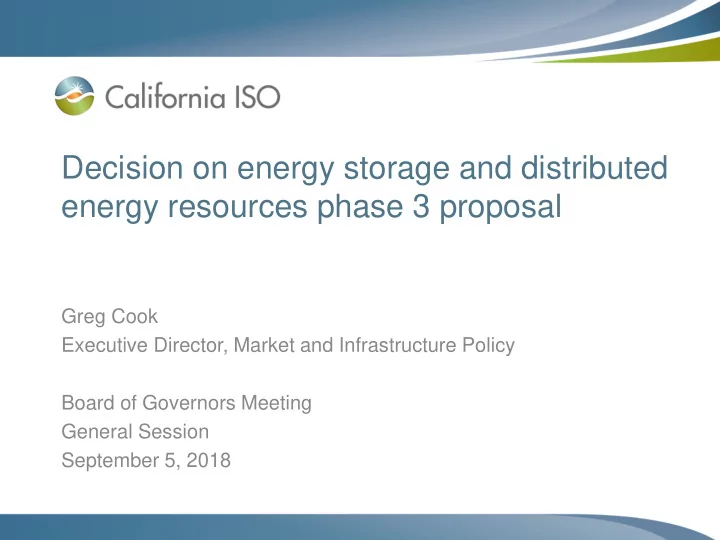

Decision on energy storage and distributed energy resources phase 3 proposal Greg Cook Executive Director, Market and Infrastructure Policy Board of Governors Meeting General Session September 5, 2018
Proposal contains four elements that require the Board of Governors approval 1. New bidding and real-time dispatch options for proxy demand resources (PDR) 2. Removal of the single load serving entity (LSE) aggregation requirement and the need for application of a default load adjustment (DLA) 3. New load shift product for behind the meter (BTM) storage 4. Measurement of behind the meter electric vehicle supply equipment (EVSE) load curtailment EIM Governing Body recommends Board approval under advisory role Page 2
1. New bidding and real-time dispatch options for demand response resources (PDR) • Today, some PDRs are committed to a Pmin of 0 MW and are unable to meet 5-min dispatches • Proposing two new bidding options for PDR real-time market participation, similar to intertie options: 1. Hourly Block – Hourly energy schedule dispatched based on forecast economic dispatch • “price taker” for real-time fifteen minute prices • Dispatch notification 52.5 minutes before operating interval 2. 15-min Dispatchable – Dispatched economically in fifteen minute market • Dispatch notification 22.5 minutes before operating interval Page 3
2. Remove single LSE requirement for demand response aggregations and eliminate DLA • Currently, DR resources must register aggregations under a single LSE and sub-LAP – Creates difficulty meeting 100 kW minimum resource size – More LSEs (CCAs) result in “stranded” customers since aggregating by LSE to reach minimum size is more challenging – Required to implement default load adjustment • Propose to remove the single LSE requirement and DLA – Default load adjustment is a settlement mechanism that mitigates double payment when a DR dispatch is not net beneficial to the system – Replace default load adjustment with a bidding rule for bids to be at or above the net benefits test price Page 4
Multiple LSEs in a single sub-LAP make creating single LSE aggregations that meet min resource size a challenge • Sub-LAP requirement prevents exacerbating congestion • Growth in CCA’s makes aggregating sufficient customers under a single LSE within a Sub-LAP more challenging Sub-LAP Today, DR must be aggregated by LSE. Customers stranded if minimum size requirement cannot be met for each LSE, i.e. LSE 3 LSE 1 LSE 2 Proposal allows customers of LSE 3 multiple LSEs to be aggregated under a single resource. Page 5
The DR Net Benefits Test establishes the price threshold where DR resource bids are deemed cost effective Price DR bids in this range have larger impact on price Net Benefits Test Price Default load adjustment triggered because of double payment Supply MW Page 6
3. Load shift product for behind the meter storage • PDR-Load Shift Resource (PDR-LSR) will allow storage to bid decreases and increases in load – Requires direct metering of behind the meter energy storage – Resource pays full retail rate for all charging energy • PDR-LSR will be designed as two separate resource IDs – Load curtailment can bid from the net benefits test threshold price up to the bid cap – Load consumption can bid < $0 to the bid floor Page 7
Certain stakeholders are requesting the PDR-LSR performance calculation modify treatment of typical use Given: 100 kW ISO Dispatch and 25 kW of typical use Typical use in opposite direction Typical use in same direction of dispatch: of dispatch: Proposed Alternative Proposed : require 125 kWh of metered Proposed : require 100 kWh of metered energy energy Alternative : deliver 75 kWh + 25 kWh credited from “typical use” Page 8
Alternative typical-use calculation can incentivize storage to charge counter to operational needs Intentionally charging during the net load ramp when discharge is needed by the bulk system creates an incentive to be dispatched and paid to stop charging CAISO Net Load Current retail rate incentive CAISO grid needs Partial-Peak Demand Peak Demand Charge (12-6pm) Charge (6-9PM) 25 kWh discharge Battery Storage 0 kWh Output 25 kWh charge Page 9
4. Enable sub-metering of behind the meter electric vehicle supply equipment (EVSE) load curtailment • Currently, an EVSE’s load curtailment value is coupled with its host facility’s DR program participation • Propose to allow an EVSE to use a sub-meter to calculate a customer load baseline for its performance that is independent of the host facility • Proposal only affects settlement value and does not allow for independent participation from host facility Page 10
Majority of stakeholders are supportive of all ESDER 3 proposals • Stakeholders fully support the new DR bidding options and removal of the single LSE requirement – DMM concerned about potential for demand response to exercise market power through commitment costs • Stakeholders in the energy storage community support the load shift product but expressed concerns with typical use calculation • Most stakeholders supportive of the recognition of sub- metered EVSE – Southern California Edison concerned with a potential gaming opportunity Slide 11
Management recommends the Board of Governors approve the ESDER 3 proposal • Provides new bidding and real-time dispatch options for demand response resources • Removes barriers for aggregating demand response resources • Establishes a new product to enable storage resources to provide consumption services to the ISO grid • Provides for separate performance measurement of electric vehicle supply equipment Slide 12
Recommend
More recommend